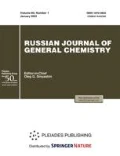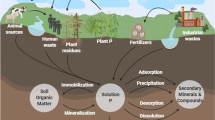Abstract
Changes in the concentration of the aluminum ions in water of experimental systems (microcosms) have been studied. The Al ion concentration was measured by the fluorescent method. As macrophytes for microcosm incubation served hornwort Ceratophyllum demersum and stonewort Chara fragilis, with the latter hydrobiont used for the first time in similar experiments. It has been convincingly proven that, in the microcosms with the aquatic plants tested, the Al ion concentration decreased much faster than in the macrophyte-free control microcosms. The data obtained suggest that Ceratophyllum demersum and Chara fragilis are promising candidates for phytoremediation applications.
Similar content being viewed by others
References
Bagrov, N.M., Osnovy otraslevykh tekhnologii: uchebnoe posobie (Basic Principles of Industry-Specific Technologies: A Textbook), St. Petersburg: GUEF, 2006.
Gorynin, I.V., Alyuminievye splavy. Primenenie alyuminievykh splavov. Spravochnoe rukovodstvo (Aluminum Alloys: Use of Aluminum Alloys: A Reference Manual), Moscow: Metallurgiya, 1978.
Klyuchnikov, N.G., Alyuminii. Uchebnoe posobie (Aluminum: A Textbook), Moscow: Gosizdat, 1958.
http://fedpress.ru/news/ecology/news_envir/zapadnosibirskii- metkombinat-zastavili-pogasit-ushcherb-zazagryaznenie- vodoemov (accessed December 4, 2015).
http://www.priroda.su/item/1869 (accessed December 3, 2015).
http://dic.academic.ru/dic.nsf/enc_colier/1021/ zagryaznenie-vody/slovari-i-entsiklopedii (accessed December 4, 2015).
http://www.ovallab.ru/him50-7.htm (accessed December 2, 2015).
Goulet, R.R., Lalonde, J.D., Munger, C., Dupuis, S., Dumont-Frenette, G., Premont, S., and Campbell, P.G., Water Res., 2005, no. 11, p. 2291.
Gallon, C., Munger, C., Premont, S., and Campbell, P.G., Water, Air, and Soil Pollution, 2004, vol. 153, p. 135.
Abu Bakar, A.F., Yusoff, I., Fatt, N.T., Othman, F., and Ashraf, M.A., Chem. Ecol., 2014, no. 1, p. 22.
Umebese, C.E. and Motajo, A.F., J. Environ. Biol., 2008, no. 2, p. 197.
Yang, Z., Chen, J., Dou, R., Gao, X., Mao, C., and Wang, L., Int. J. Environ. Res. Public Health, 2015, no. 12, p. 15100.
Bespamyatnov, G.P. and Krotov, Yu.A., Predel’nodopustimye kontsentratsii khimicheskikh veshchestv v okruzhayushchei srede. Spravochnik (Maximum Permissible Concentrations of Chemicals in the Environment: A Handbook), Leningrad: Khimiya, 1985.
Okruzhayushchaya sreda: Entsiklopedicheskii slovar’- spravochnik (Environment: Encyclopedic Dictionary), Moscow: Progress, 1993. http://www.etch.ru/ norma.php?art=4 (accessed December 1, 2015).
Ivanter, E.V. and Medvedev, N.V., Ekologicheskaya toksikologiya prirodnykh populyatsii (Environmental Toxicology of Natural Populations), Moscow: Nauka, 2007.
Donchenko, V.K., Ivanova, V.V., and Pitul’ko, V.M., Ekologo-khimicheskie osobennosti pribrezhnykh akvatorii (Ecological and Chemical Features of Coastal Water Areas), St. Petersburg: NITsEB RAN, 2008.
Ostroumov, S.A., Hydrobiol., 2002, vol. 469, p. 203.
Ostroumov, S.A., Kolesov, G.M., Poklonov, V.A., and Kotelevtsev, S.V., Ekol. Khim., 2009, vol. 18, no. 4, p. 222.
Ostroumov, S.A., Kotelevtsev, S.V., Shestakova, T.V., Kolotilova, N.N., Poklonov, V.A., and Solomonova, E.A., Ekol. Khim., 2009, vol. 18, no. 2, p. 111.
Poklonov, V.A., Ekol. Vestn. Ross., 2015, no. 12, p. 66.
Poklonov, V.A., Voda: Khim. Ekol., 2015, no. 10, p. 82.
Ostroumov, S.A., Shestakova, T.V., Kotelevtsev, S.V., Solomonova, E.A., Golovnya, E.G., and Poklonov, V.A., Vodn. Khoz. Ross., 2009, no. 2, p. 58.
Author information
Authors and Affiliations
Corresponding author
Additional information
Original Russian Text © V.A. Poklonov, 2016, published in Ekologicheskaya Khimiya, 2016, Vol. 25, No. 2, pp. 79–85.
Rights and permissions
About this article
Cite this article
Poklonov, V.A. Removal of aluminum by aquatic plants Ceratophyllum demersum and Chara fragilis from water of experimental ecosystems. Russ J Gen Chem 86, 2978–2982 (2016). https://doi.org/10.1134/S1070363216130089
Received:
Published:
Issue Date:
DOI: https://doi.org/10.1134/S1070363216130089




